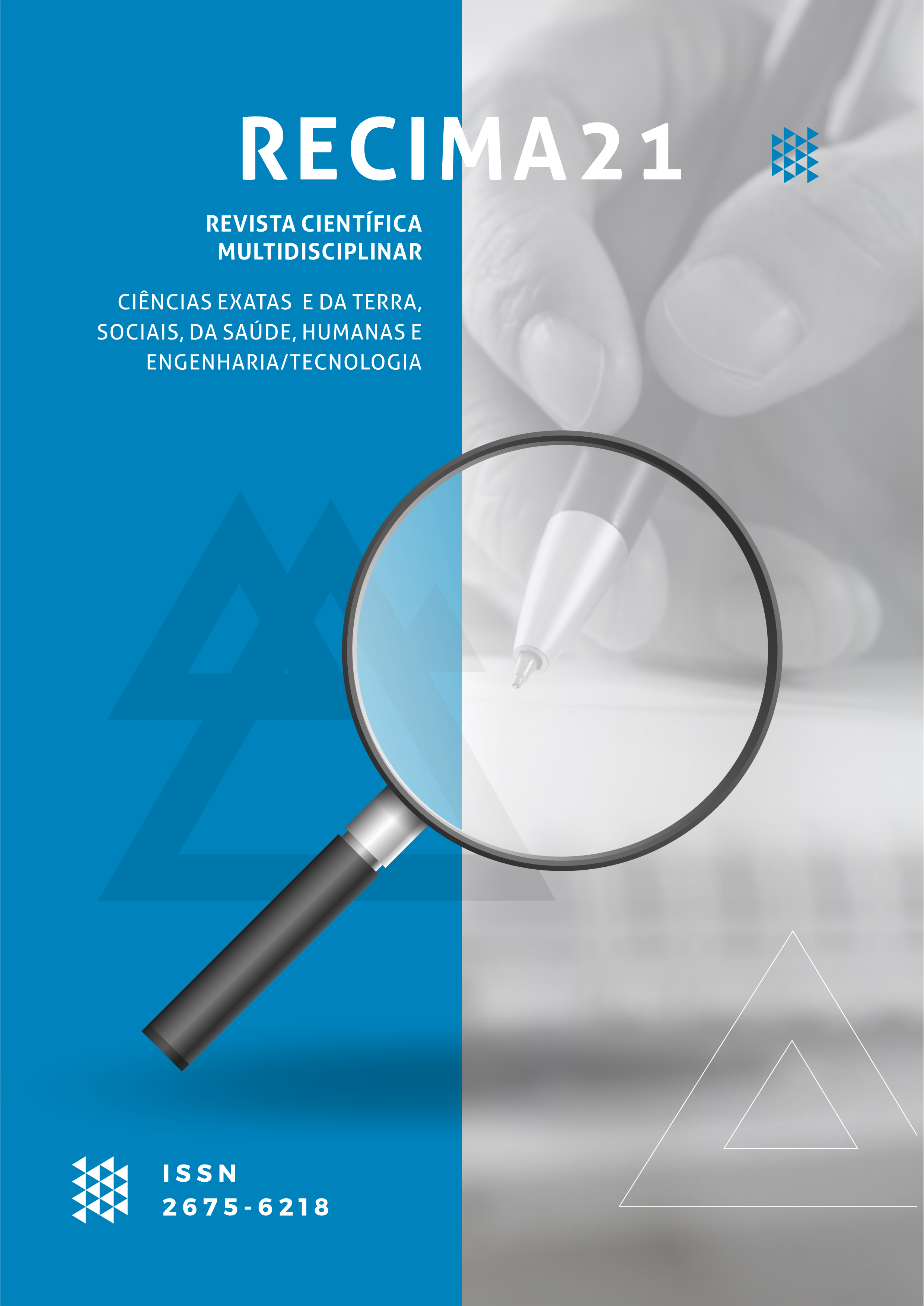A PRÁTICA DA AMAMENTAÇÃO EM MULHERES COM TRAUMA MAMILAR
DOI:
https://doi.org/10.47820/recima21.v3i12.2296Palavras-chave:
Aleitamento MaternoResumo
O trauma mamilar é a ruptura do tecido epitelial que cobre o mamilo e geralmente surge nos primeiros dias de amamentação. Por causar dor de intensidades variadas, a fissura pode ocasionar o desmame precoce. Este estudo objetivou compreender a influência do trauma mamilar, na percepção das nutrizes, sobre a prática da amamentação. Para isto, foi realizada uma pesquisa qualitativa com 12 nutrizes que apresentavam fissura mamilar e estavam amamentando exclusivamente. A análise dos dados permitiu a divisão dos resultados em três categorias. Na primeira categoria, as mulheres atribuíram o ato de amamentar apresentando fissura mamilar como algo que trouxe dor, medo e choro, causado pela inexperiência e pela amamentação não corresponder às suas expectativas culminando com a vontade de introduzir outros alimentos na dieta da criança. De acordo com a segunda categoria, a manutenção do aleitamento deveu-se a estas mulheres priorizarem o cuidado com a criança em detrimento da própria dor, reconhecerem a importância do leite materno e seu valor nutricional e apresentarem leite suficiente para suprir as demandas do neonato. A terceira categoria versa sobre o apoio do Banco de Leite Humano para continuidade do aleitamento. Faz-se necessário que os profissionais de saúde atuem não apenas no biológico, mas considerem a amamentação como algo social onde o protagonismo é da lactante.
Downloads
Referências
Costa S, Fettermann FA, Azevedo LA, Freitas HMB, Bordignon JS, Donaduzzi DSS. A prática do aleitamento materno na percepção de mulheres primigestas. Rev Vivências. 2019; 15(29): 289-310
Moura ACL, Lira JP, Sousa TRS. Boas práticas de desmame na perspectiva de enfermagem: revisão integrativa de literatura. SAJES. 2021; 7(14): 35-52
Morais TC, Freitas PX, Neves, JB. Percepção das primigestas acerca do aleitamento materno. Revista Enfermagem Integrada. 2012; 3(2).
Ciampo LA, Ciampo IRL. Breastfeeding and the Benefits of Lactation for Women’s Health. Rev Bras Ginecol Obstet 2018; 40:354–359.
Fontoura T. Aleitamento materno: uma perspectiva psicológica. Rev Téc-Cient Enferm. 2004; 2(10):224-8.
Brito DO, Oliveira AS, Perillo VCA. Aspectos corporais, afetivos, anatômicos e funcionais no aleitamento materno. Saber científico. 2008; 1(1):194-208
WHO. Global data bank on infant and young child feeding. World Health Organization, 2009.
Coca KP; Gamba MA; Silva RS; Abrão ACFV. Fatores associados ao trauma mamilar na maternidade. J Pediatr. 2009; 85(4):341-5.
Primo CC; Caetano LC. A decisão de amamentar da nutriz: percepção de sua mãe. J Pediatr. 1999; 75(6):449-55
Turato, ER. Tratado da metodologia da pesquisa clínico-qualitativa. Construção teórico-epistemológico, discussão comparada e aplicação nas áreas da saúde e humanas. 2. ed. Petrópolis: Vozes: 2003.
Bandin L. Análise de conteúdo. 70.ed Lisboa: 2007.
Nakano AMS, Reis MCG, Pereira MJB, Gomes FA. O espaço social das mulheres e a referência para o cuidado na prática da amamentação Rev Latino-am Enfermagem 2007; 15(2):230-8.
Moreira MA. Os novos significados da amamentação em primíparas que vivenciaram fissuras mamárias, na perspectiva de gênero. In: Fazendo gênero 8 – Corpo, Violência e Poder; 25-28 agosto 2008; Florianópolis.
Silva MBCS, Moura MEB, Silva AO. Desmame precoce: representações sociais de mães. Rev Eletr Enf. 2007; 9(01):31-50.
Gonçalves SA, Filipini R, Posso MBS. Dor mamilar durante a amamentação: ação analgésica do laser de baixa intensidade. Rev Dor. 2009; 10(2)125-9.
Montrone AVG, Arantes CIS, Nassar ACS, Zanon T. Trauma mamilar e a prática de amamentar: estudo com mulheres no início da Lactação. Rev APS. 2006; 9(2): 168-174.
Ramos CV, Almeida JAG. Alegações maternas para o desmame: estudo qualitativo. J Pediatr. 2003; 79(5): 385-90.
Silva IMD, Silva KV, Leal LPL, Javorski M. Técnica da amamentação: preparo das nutrizes atendidas em um hospital escola, Recife-PE. Rev Rene. 2011; 12 (n. esp.): 1021-27.
Takushi SAM, Tanaka ACA, Gallo PR, Machado MAMP. Motivação de gestantes para o aleitamento materno Rev. Nutr. 2008; 21(5):491-502.
Machado MMT, Bosi MLM.Compreendendo a prática do aleitamento exclusivo: um estudo junto a lactantes usuárias da Rede de Serviços em Fortaleza, Ceará, Brasil. Rev. Bras. Saúde Matern. Infant. 2008; 8(2):187-196.
Nakano AMS. As vivências da amamentação para um grupo de mulheres: nos limites de ser "o corpo para o filho" e de ser "o corpo para si". Cad. Saúde Pública. 2003; 19(Sup. 2):S355-S363.
Giugliani ERJ. Problemas comuns na lactação e seu manejo. J Pediatr. 2004; 80 (Supl 5):S147-S154.
Shimoda GT, Silva IA. Necessidades de saúde de mulheres em processo de amamentação. Rev Bras Enferm. 2010; 63(1):58-65.
Downloads
Publicado
Edição
Secção
Categorias
Licença
Direitos de Autor (c) 2022 RECIMA21 - Revista Científica Multidisciplinar - ISSN 2675-6218

Este trabalho encontra-se publicado com a Licença Internacional Creative Commons Atribuição 4.0.
Os direitos autorais dos artigos/resenhas/TCCs publicados pertecem à revista RECIMA21, e seguem o padrão Creative Commons (CC BY 4.0), permitindo a cópia ou reprodução, desde que cite a fonte e respeite os direitos dos autores e contenham menção aos mesmos nos créditos. Toda e qualquer obra publicada na revista, seu conteúdo é de responsabilidade dos autores, cabendo a RECIMA21 apenas ser o veículo de divulgação, seguindo os padrões nacionais e internacionais de publicação.













